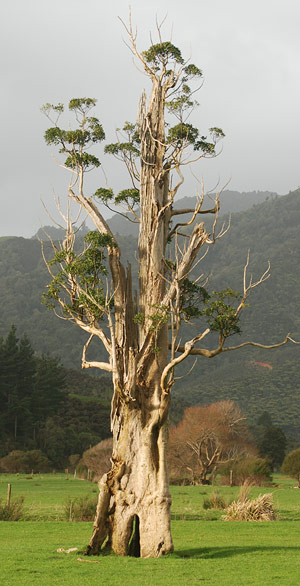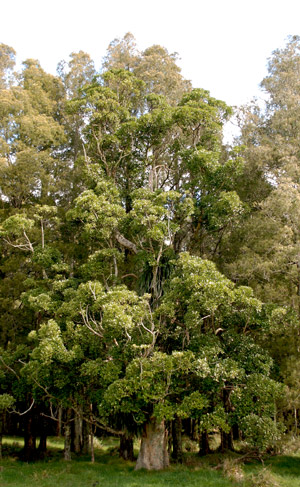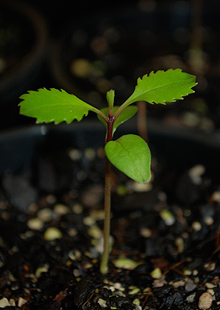| |
NEW ZEALAND ECOLOGY |
| |
|
|
BIG CONIFER AND BROADLEAF TREES |
| |
| |
Pukatea Laurelia novae-zelandiae is a member of the Atherospermataceae family, of the Laurales order, and is endemic to New Zealand.
The genus Laurelia has only two species, with just the one in New Zealand and Laurelia sempervirens in Chile. The genus is somewhat unusual in having both sexes separate on the same tree, and occasionally together on the same flower.
Pukatea is a tall broadleaf, flowering forest tree reaching up to 35 metres, with a straight trunk 2 metres in diameter. Broad flanking buttresses, or plank buttresses, triangular in shape form at the base of mature trees.
Like rata, pukatea attracts more than its' fair share of parasitic plants, with mature trees so heavily burdened with Astelia and Freycinetia that there appears to be just as much, if not more epiphyte foliage than leaf foliage.
It is well known as a swamp tree, sometimes growing in standing water, due to the growth of pneumatophores or breathing roots. These grow out of the water, sometimes as much as a metre, and loop over and back down to send oxygen to the roots. |
| |
 |
| |
The genus Laurelia is unusual, with both sexes separate on the same tree, and occasionally together on the same flower. |
| |
 |
| |
In wetlands, pukatea is most often associated with more predominant kahikatea Dacrycarpus dacrydioides, and sometimes with swamp maire Syzygium maire which is reliant on saturated ground and also sends up breathing roots above water.
With 90 percent of New Zealand's wetlands drained and converted for farmland, many pukatea of the former vast areas of swamp forest in the North Island have been lost.
Buttresses are root tissue that assist aeration, so they are normally associated with poorly aerated swampy soils, or pure swamp conditions, and develop in large trees to provide support.
Pukatea is the only New Zealand tree with well defined, flat, thin plank buttresses, which are a tendency of swamp trees in tropical and sub-tropical climates. The thin buttresses grow up the trunk and along the roots, sometimes extending a few metres, to stabilise large trees in wet ground or swamp.
Kahikatea in swamps may develop less defined rounded buttresses that curve downward. Some beech species and kohekohe also have rounded buttresses.
Pukatea is a fast growing tree that does well in damp conditions in forest, particularly in gulleys and stream riparian areas. As a forest tree it has a clean straight trunk without branches up to a great height. A mature trunk however, may become clothed in lianes, mosses, lichens, small ferns, and many epiphytes are prolific in the forks of branches. |
| |
|
 |
| |
| |
Above: A very old pukatea with its' top blown off and buttresses buried in alluvial sediment, hanging on to life. It is difficult to destroy pukatea by fire, so this tree has probably survived when kahikatea was burnt off for pasture. Photo Copyright © Graeme Woodhouse 2013.
 Return to big conifer and broadleaf trees Return to big conifer and broadleaf trees
|
| |
 |
| |
Pukatea is found from sea level to 600 metres throughout the North Island, and in the South Island in Marlborough and on the west coast as far south as Fiordland.
Leaves are 5 to 8cm long, leathery and thick, and shaped from elliptic to elliptic-obovate with the margins serrated bluntly and coursely. The top of the leaf is dark glossy green, and the bottom is less shiny and a paler green .
The pale brown pukatea wood is strong but is not durable and has not had much commercial value, except for boatbuilding. |
| |
 |
| |
Below: A pukatea Laurelia novae-zelandiae with kahikatea in swamp forest in the riparian area of Kiritehere Stream, Kiritehere, Waitomo District.
Photo Copyright © Graeme Woodhouse 2009. |
| |
| |
 |
| |
|
| |
Above: [1] Part of an exceptional, very rare remnant stand, principally containing pukatea, Marokopa, Waitomo District.
[2] Pukatea in the Kiritehere Stream riparian area. Tall, clean trunks show they were part of a tall forest before it was cleared for farming.
[3] Epiphytes take over the canopy, leaving little trace of pukatea foliage in primary rimu/tawa forest in the riparian area of a Rararimu Stream tributary, Rararimu Stream Scenic Reserve, Waitomo District.
[4] The hollow trunk at the base of a very old pukatea that will just not quit, Moeatoa, Waitomo District.
[5] Plank buttresses on a pukatea in the Rararimu Stream Scenic Reserve.
Below: A 6 cm tall pukatea seedling in a TerraNature native plant nursery.
All photos Copyright © Graeme Woodhouse 2013. |
| |
|

A unisexual & bisexual, polygamous tree .....
A typical 'perfect', bisexual, or hermafrodite flower, is a bisporangiate strobilus containing both male and female reproductive organs, producing pollen (male spores), and ovules (female spores).
The male Androecium with one or two whorls of stamen produce pollen. The female Gynoecium of one or more pistils in a carpel contains an ovary, and the pistil's sticky tip, the stigma, is the pollen receptor. This is the pathway of pollen grains carrying the reproductive material to the ovules.
The short space from male to female organs in a 'perfect' flower facilitates the transfer of pollen by insects or wind.
In some plant species which are regarded as dioecious, flowers are 'imperfect', or unisexual, with either male stamens, or female pistil reproductive parts. Pollen must be transported from a male to a female plant.
A third reproductive arrangement is in monoecious plants, in which unisexual male and female flowers are on the same plant.
Pukatea is unusual in having separate unisexual male and female flowers, and occasionally, 'perfect' or bisexual flowers (containing male and female reproductive organs) on the same tree.
Pukatea is a 'trimonoecious' plant (polygamous), with male, female and hermaphrodite flowers on the same plant.
The small 6mm flowers are light green in both sexes, but the stamens are tinged red in male and bisexual flowers.
|
| |
 |
|

